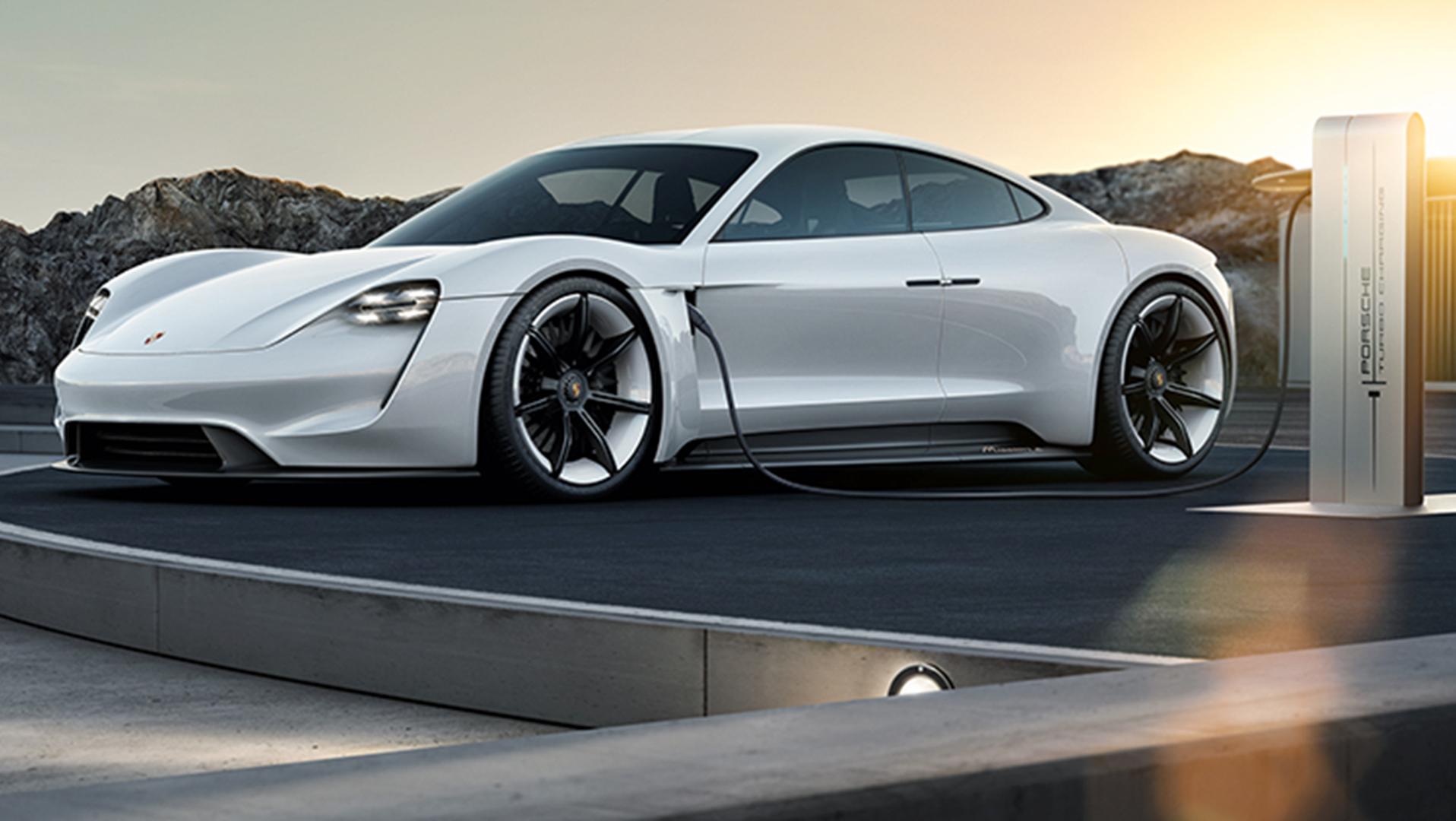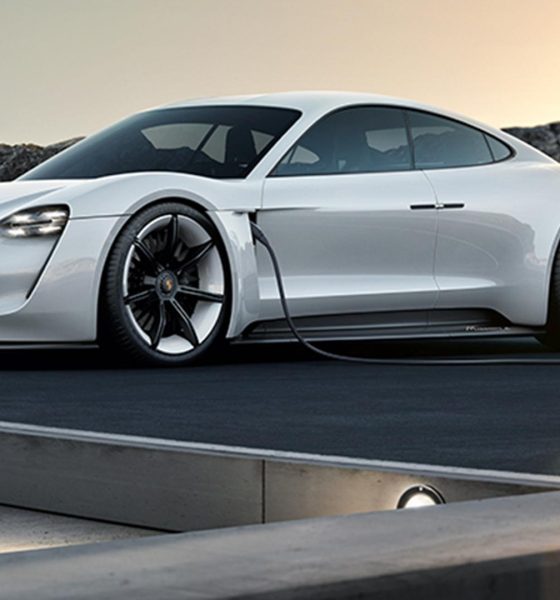

News
Porsche Taycan gets three years free charging, 320 kW “Turbo Chargers” coming to dealer network
As Porsche prepares for the launch of its first all-electric car — the highly-anticipated Taycan — the carmaker has begun setting the stage for the vehicle’s rollout in the United States. On Monday, Porsche Cars North America, Inc. (PCNA) announced an agreement with Electrify America to provide the Taycan with three years of unlimited fast charging at public stations across the country. With this system in place, as well as Electrify America’s ongoing expansion, the Taycan would be capable of long-distance, coast-to-coast travel.
In a press release about the update, Porsche noted that the charging perk would be included in the Taycan’s selling price. Under the system, Taycan buyers would receive three years of unlimited 30-minute fast charging at Electrify America locations, which is comprised of over 300 highway stations in 42 states, on top of more than 180 sites in 17 select metro areas. The established carmaker stated that each Electrify America location would have an average of five charging stalls, while some sites would have enough support for up to 10 vehicles at once.
Apart from its deal with Electrify America, Porsche has also announced that its dealers would be installing their own fast-charge Turbo Charger kiosks for the company’s upcoming all-electric vehicle. Porsche would also be releasing products for home charging solutions. In a statement, Klaus Zellmer, President and CEO of PCNA, pointed out that this trifecta of charging systems — Electrify America’s infrastructure, Turbo Chargers in dealers, and home chargers — would ultimately free future Taycan owners from range anxiety.

“Every Porsche is a sports car with soul, and the Taycan is soul electrified. Together, Electrify America and our Porsche dealer network will provide a national infrastructure for DC fast charging that frees future Taycan owners from range anxiety. And Porsche home charging technology will turn the customer’s garage into the equivalent of a personal gas station,” the CEO said.
One thing that separates the Taycan from the conventional electric car is its capability to charge at an extremely rapid rate. Using 350 kW chargers, 800-volt technology, and the combined charging system (CCS) standard, the Taycan would be able to add more than 60 miles of range in just four minutes. That’s the fastest charging capabilities in the market today, roughly three times faster than Tesla’s expansive Supercharger Network.
To take advantage of the Taycan’s ultra-fast-charging capabilities, Electrify America’s highway stations would have a minimum of two 350 kW chargers per site, with additional stalls delivering up to 150 kW. Metro stations, on the other hand, would be capable of charging at speeds of up to 150 kW as well. Electrify America is expected to have 484 locations with 2,000 charging stalls completed or under construction by July 1, ahead of the Taycan’s release in late 2019.

While free 3-year unlimited access to Electrify America’s chargers would undoubtedly be a notable selling point for the Taycan, Porsche’s dealers across the country would also be offering their own charging perk. The automaker has noted that all 191 of its US dealers would be installing DC fast-charging stations for the upcoming vehicle, 120 of which would feature Porsche Turbo Charging — the company’s proprietary DC/CCS charging system that delivers up to 320 kW. Porsche dealers without Turbo Chargers would feature 50 kW fast chargers on site.
The Porsche Experience Center (PEC) in Atlanta, GA already hosts the company’s first Turbo Chargers. More of Porsche’s own charging stations are expected to be installed at the PEC in Los Angeles, CA in the near future.
The Porsche Taycan is the first all-electric vehicle from the automaker. In true Porsche spirit, the Taycan boasts impressive specs, from a 0-60 mph time of 3.5 seconds, a top speed of 155 mph, and a range of 310 miles per charge. The company has also noted that just like its iconic vehicles like the legendary Porsche 911, the Taycan would be at home at the racetrack being driven to its limits. As noted by a Porsche brand ambassador in an email to an auto journalist last month, the Taycan would be offered in three models — an entry-level variant, the mid-range Taycan 4S, and the range-topping Taycan Turbo, which would likely cost over $130,000 before options.
Note from Editor:
Last Friday, Electrify America partially shut down its charging infrastructure due to safety concerns from HUBER+SUHNER, the supplier for the network’s charging cables. A spokesperson from Porsche Cars North America tells Teslarati some details on Electrify America’s partial network shutdown:
“Electrify America notified us immediately about the partial shutdown of their charging network due to a concern with one of their liquid-cooling cable suppliers. We are confident that Electrify America and their supplier will move quickly to complete an investigation and resolve this issue well in advance of our public launch of the Porsche Taycan late this year.”

Elon Musk
Elon Musk confirms xAI’s purchase of five 380 MW natural gas turbines
The deal, which was confirmed by Musk on X, highlights xAI’s effort to aggressively scale its operations.

xAI, Elon Musk’s artificial intelligence startup, has purchased five additional 380 MW natural gas turbines from South Korea’s Doosan Enerbility to power its growing supercomputer clusters.
The deal, which was confirmed by Musk on X, highlights xAI’s effort to aggressively scale its operations.
xAI’s turbine deal details
News of xAI’s new turbines was shared on social media platform X, with user @SemiAnalysis_ stating that the turbines were produced by South Korea’s Doosan Enerbility. As noted in an Asian Business Daily report, Doosan Enerbility announced last October that it signed a contract to supply two 380 MW gas turbines for a major U.S. tech company. Doosan later noted in December that it secured an order for three more 380 MW gas turbines.
As per the X user, the gas turbines would power an additional 600,000+ GB200 NVL72 equivalent size cluster. This should make xAI’s facilities among the largest in the world. In a reply, Elon Musk confirmed that xAI did purchase the turbines. “True,” Musk wrote in a post on X.
xAI’s ambitions
Recent reports have indicated that xAI closed an upsized $20 billion Series E funding round, exceeding the initial $15 billion target to fuel rapid infrastructure scaling and AI product development. The funding, as per the AI startup, “will accelerate our world-leading infrastructure buildout, enable the rapid development and deployment of transformative AI products.”
The company also teased the rollout of its upcoming frontier AI model. “Looking ahead, Grok 5 is currently in training, and we are focused on launching innovative new consumer and enterprise products that harness the power of Grok, Colossus, and 𝕏 to transform how we live, work, and play,” xAI wrote in a post on its website.
Elon Musk
Elon Musk’s xAI closes upsized $20B Series E funding round
xAI announced the investment round in a post on its official website.

xAI has closed an upsized $20 billion Series E funding round, exceeding the initial $15 billion target to fuel rapid infrastructure scaling and AI product development.
xAI announced the investment round in a post on its official website.
A $20 billion Series E round
As noted by the artificial intelligence startup in its post, the Series E funding round attracted a diverse group of investors, including Valor Equity Partners, Stepstone Group, Fidelity Management & Research Company, Qatar Investment Authority, MGX, and Baron Capital Group, among others.
Strategic partners NVIDIA and Cisco Investments also continued support for building the world’s largest GPU clusters.
As xAI stated, “This financing will accelerate our world-leading infrastructure buildout, enable the rapid development and deployment of transformative AI products reaching billions of users, and fuel groundbreaking research advancing xAI’s core mission: Understanding the Universe.”
xAI’s core mission
Th Series E funding builds on xAI’s previous rounds, powering Grok advancements and massive compute expansions like the Memphis supercluster. The upsized demand reflects growing recognition of xAI’s potential in frontier AI.
xAI also highlighted several of its breakthroughs in 2025, from the buildout of Colossus I and II, which ended with over 1 million H100 GPU equivalents, and the rollout of the Grok 4 Series, Grok Voice, and Grok Imagine, among others. The company also confirmed that work is already underway to train the flagship large language model’s next iteration, Grok 5.
“Looking ahead, Grok 5 is currently in training, and we are focused on launching innovative new consumer and enterprise products that harness the power of Grok, Colossus, and 𝕏 to transform how we live, work, and play,” xAI wrote.
Investor's Corner
Tesla gets price target bump, citing growing lead in self-driving

Tesla (NASDAQ: TSLA) stock received a price target update from Pierre Ferragu of Wall Street firm New Street Research, citing the company’s growing lead in self-driving and autonomy.
On Tuesday, Ferragu bumped his price target from $520 to $600, stating that the consensus from the Consumer Electronics Show in Las Vegas was that Tesla’s lead in autonomy has been sustained, is growing, and sits at a multiple-year lead over its competitors.
CES 2026 validates Tesla’s FSD strategy, but there’s a big lag for rivals: analyst
“The signal from Vegas is loud and clear,” the analyst writes. “The industry isn’t catching up to Tesla; it is actively validating Tesla’s strategy…just with a 12-year lag.”
The note shows that the company’s prowess in vehicle autonomy is being solidified by lagging competitors that claim to have the best method. The only problem is that Tesla’s Vision-based approach, which it adopted back in 2022 with the Model 3 and Model Y initially, has been proven to be more effective than competitors’ approach, which utilizes other technology, such as LiDAR and sensors.
Currently, Tesla shares are sitting at around $433, as the company’s stock price closed at $432.96 on Tuesday afternoon.
Ferragu’s consensus on Tesla shares echoes that of other Wall Street analysts who are bullish on the company’s stock and position within the AI, autonomy, and robotics sector.
Dan Ives of Wedbush wrote in a note in mid-December that he anticipates Tesla having a massive 2026, and could reach a $3 trillion valuation this year, especially with the “AI chapter” taking hold of the narrative at the company.
Ives also said that the big step in the right direction for Tesla will be initiating production of the Cybercab, as well as expanding on the Robotaxi program through the next 12 months:
“…as full-scale volume production begins with the autonomous and robotics roadmap…The company has started to test the all-important Cybercab in Austin over the past few weeks, which is an incremental step towards launching in 2026 with important volume production of Cybercabs starting in April/May, which remains the golden goose in unlocking TSLA’s AI valuation.”
Tesla analyst breaks down delivery report: ‘A step in the right direction’
Tesla has transitioned from an automaker to a full-fledged AI company, and its Robotaxi and Cybercab programs, fueled by the Full Self-Driving suite, are leading the charge moving forward. In 2026, there are major goals the company has outlined. The first is removing Safety Drivers from vehicles in Austin, Texas, one of the areas where it operates a ride-hailing service within the U.S.
Ultimately, Tesla will aim to launch a Level 5 autonomy suite to the public in the coming years.








